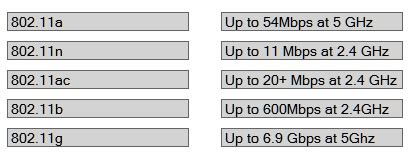802.11 speed chart - wifi standards and speeds chart : 2024-11-01 802.11 speed chart Wi-Fi 7, also known as 802.11be, promises another massive leap in speed with a peak data rate of over 40Gbps. 802.11 speed chartCrisp and clean, warm and sexy, CHANEL ALLURE HOMME Eau de Toilette is the expression of a man's charisma and inner strength. The fresh, spicy and woody composition reveals the presence of the man who wears it. Difficult to define, impossible to resist. Details. How To Use. Ingredients. Shipping & Coupon Restrictions. Our Picks For .
$199.00
802.11 speed chart How can you sort out the mess of Wi-Fi standards? Here's the rundown on what the major standards are, and what. There's 801.22a, 802.11b, 802.11g, pre-N, .802.11 speed chartEach network can be broken down by a few different settings: Speed: How much data the network can transmit. This is calculated in Mbps (1 million bits per second) Frequency: What radio frequency the network is carried . Wi-Fi standards are a set of specifications for wireless connectivity. These standards are introduced by the IEEE and certified and approved by the Wi-Fi Alliance. Many users are not aware of these . Data rates differ based on which frequency is being used, bandwidth speeds up to 1300 Mbps can be achieved on the 5 GHz band, while the 2.4 GHz band has a max speed of 450 Mbps. The IEEE 802.11 chart below gives a small overview of many of the WiFi standards. WiFi Standards: . Designed to improve handoff speed between access points in a WLAN. 802.11s: N/A : 2011: .

The 802.11 wireless standards can differ in terms of speed, transmission ranges, and frequency used, but in terms of actual implementation they are similar. All standards can use either an infrastructure or ad hoc network design, and each can use the same security protocols. Ad hoc and infrastructure wireless topologies were discussed in Chapter 1.IEEE 802.11n is an amendment to IEEE 802.11-2007 as amended by IEEE 802.11k-2008, IEEE 802.11r-2008, IEEE 802.11y-2008, and IEEE 802.11w-2009, and builds on previous 802.11 standards by adding a multiple-input multiple-output (MIMO) system and 40 MHz channels to the PHY (physical layer) and frame aggregation to the MAC layer.There .This also operated in the 2.4 gigahertz range, and very similar to 802.11a, we had an increase in speed up to 54 megabits-per-second. This 802.11g standard was designed to be an upgrade and to be backwards-compatible with 802.11b, but it had the same 2.4 gigahertz frequency conflicts that we saw with the 802.11b standard.IEEE 802.11ac-2013 or 802.11ac is a wireless networking standard in the IEEE 802.11 set of protocols (which is part of the Wi-Fi networking family), providing high-throughput wireless local area networks (WLANs) on the 5 GHz band. [c] The standard has been retroactively labelled as Wi-Fi 5 by Wi-Fi Alliance.[9] [10]The specification has multi-station .IEEE 802.11be, dubbed Extremely High Throughput (EHT), is a wireless networking standard in the IEEE 802.11 set of protocols, [9] [10] which is designated Wi-Fi 7 by Wi-Fi Alliance. [11] [12] [13] It has built upon 802.11ax, focusing on WLAN indoor and outdoor operation with stationary and pedestrian speeds in the 2.4, 5, and 6 GHz frequency .
802.11 speed chart Increased Bandwidth and Speed: Wi-Fi 7 is designed to deliver a maximum throughput of up to 40Gbps and 46Gbps [PDF], more than three times faster than Wi-Fi 6's 9.6Gbps. 320 MHz Channels: Wi-Fi 7 will support wider channel bandwidths, up to 320 MHz, compared to the maximum of 160 MHz on Wi-Fi 6. This allows for more efficient . 802.11g. Released in 2003. Data rates with varying modulation types: 6, 9, 12, 18, 24, 36, 48 and 54 Mbps; can revert to 1, 2, 5.5, and 11 Mbps using DSSS and CCK.Approved in June 2003, 802.11g was the successor to 802.11b, able to achieve up to 54 Mbps rates in the 2.4 GHz band, matching 802.11a speed but within the lower frequency range. 4.Wi-Fi 4 (802.11n) The first standard to specify MIMO, 802.11n was approved in . A Wi-Fi network connection operates at the highest possible speed that both devices, often referred to as endpoints, support. An 802.11g laptop connected to an 802.11n router, for example, networks at the lower speed of the 802.11g laptop. Both devices must support the same standard to operate at the higher speed.802.11 WiFi devices claim so many different amazing wireless speeds, especially with the introduction of 802.11ac, that it is sometimes hard to make sense of. IEEE P802.11be, along with IEEE 802.11ax and future iterations of IEEE 802.11 standards, also could support many next-generation Wi-Fi applications. The IEEE 802.11 Working Group has established several special-interest groups to investigate many of them. Here are a few examples: Battery-Free, Ambient Power-Enabled Internet of .
Eau de Toilette Spray - 3.4 FL. OZ. $130. Shop ALLURE HOMME SPORT Eau de Toilette Spray - 3.4 FL. OZ. and discover more Fragrances at CHANEL.com. Shop now and enjoy complimentary samples.
802.11 speed chart